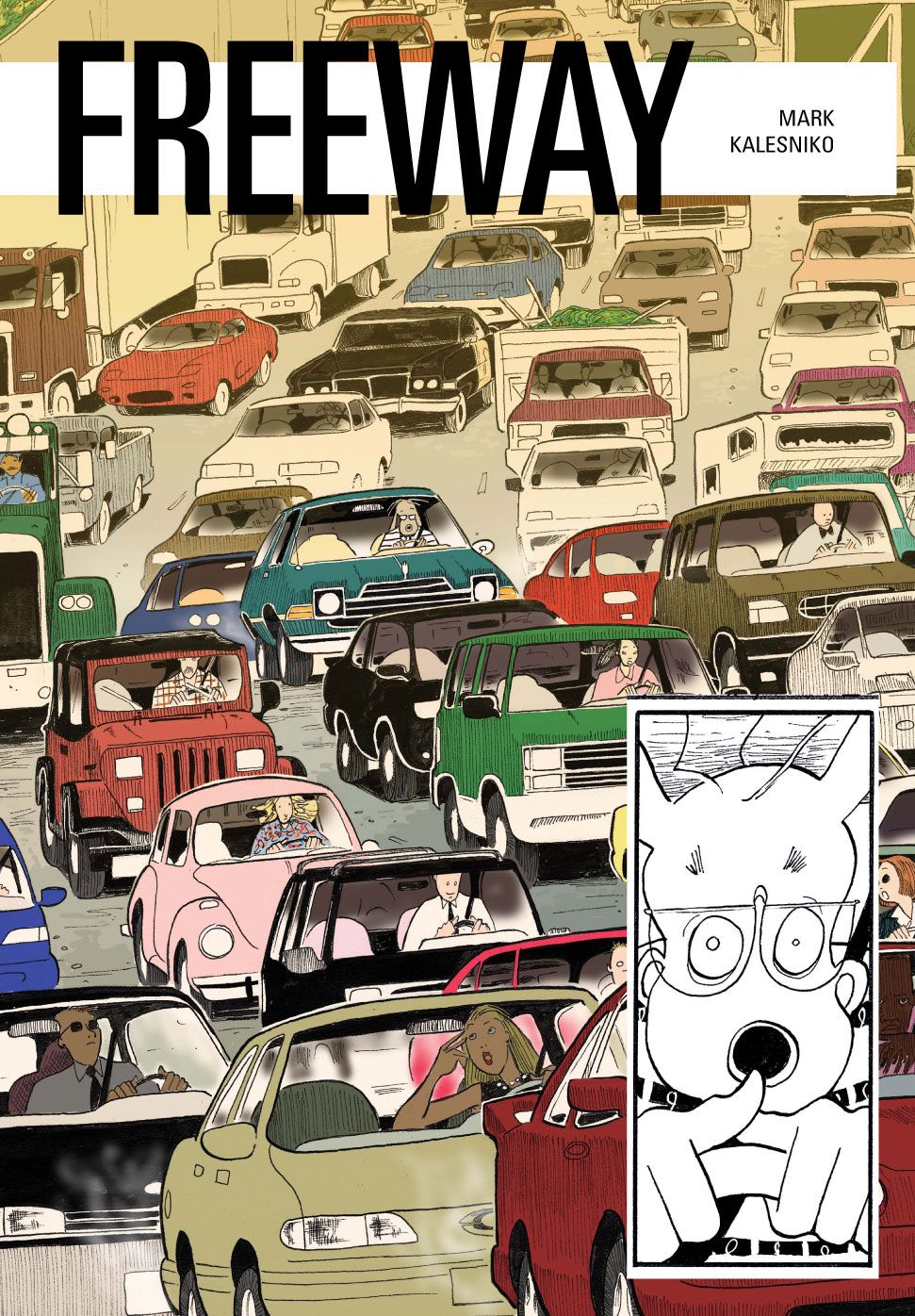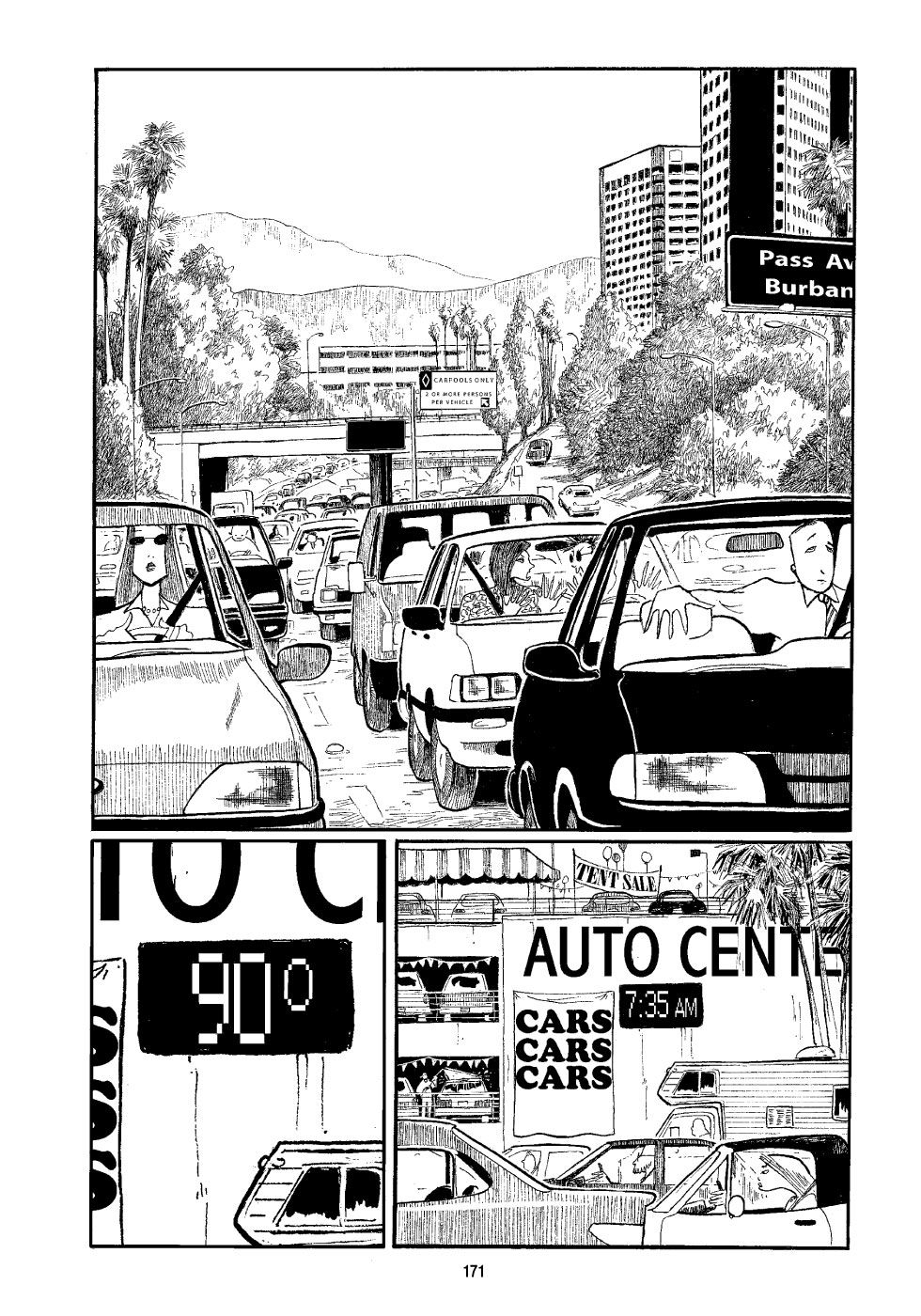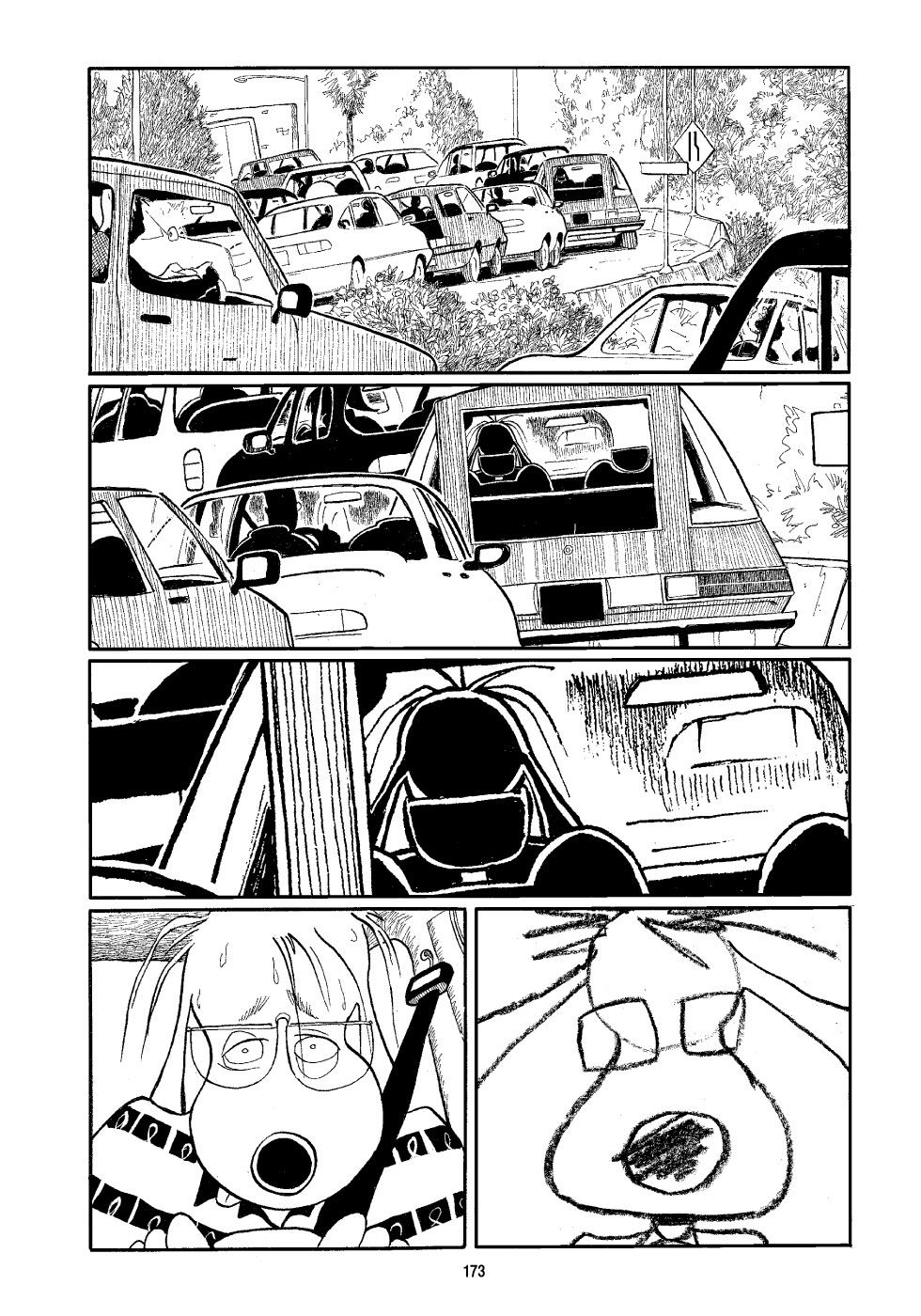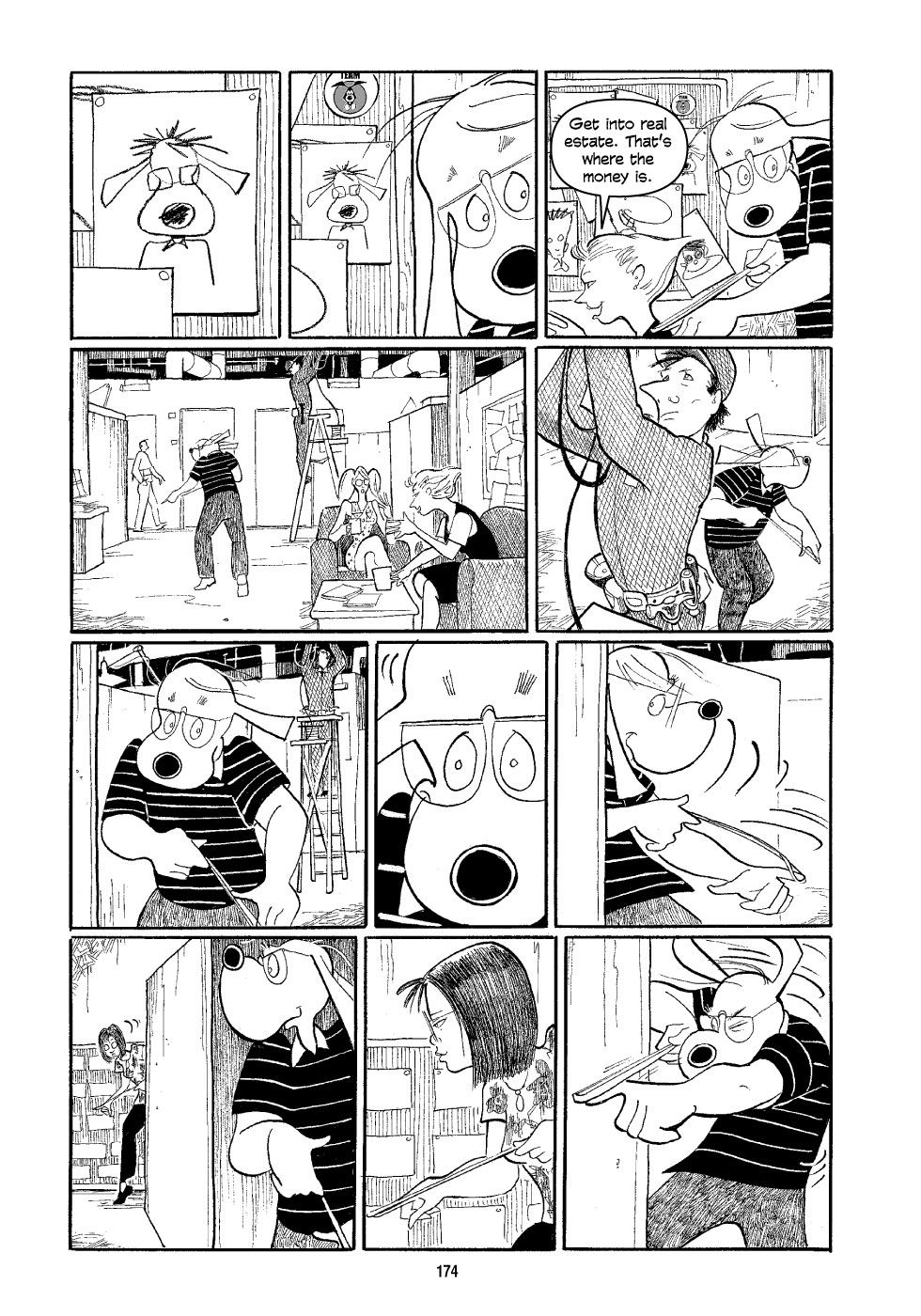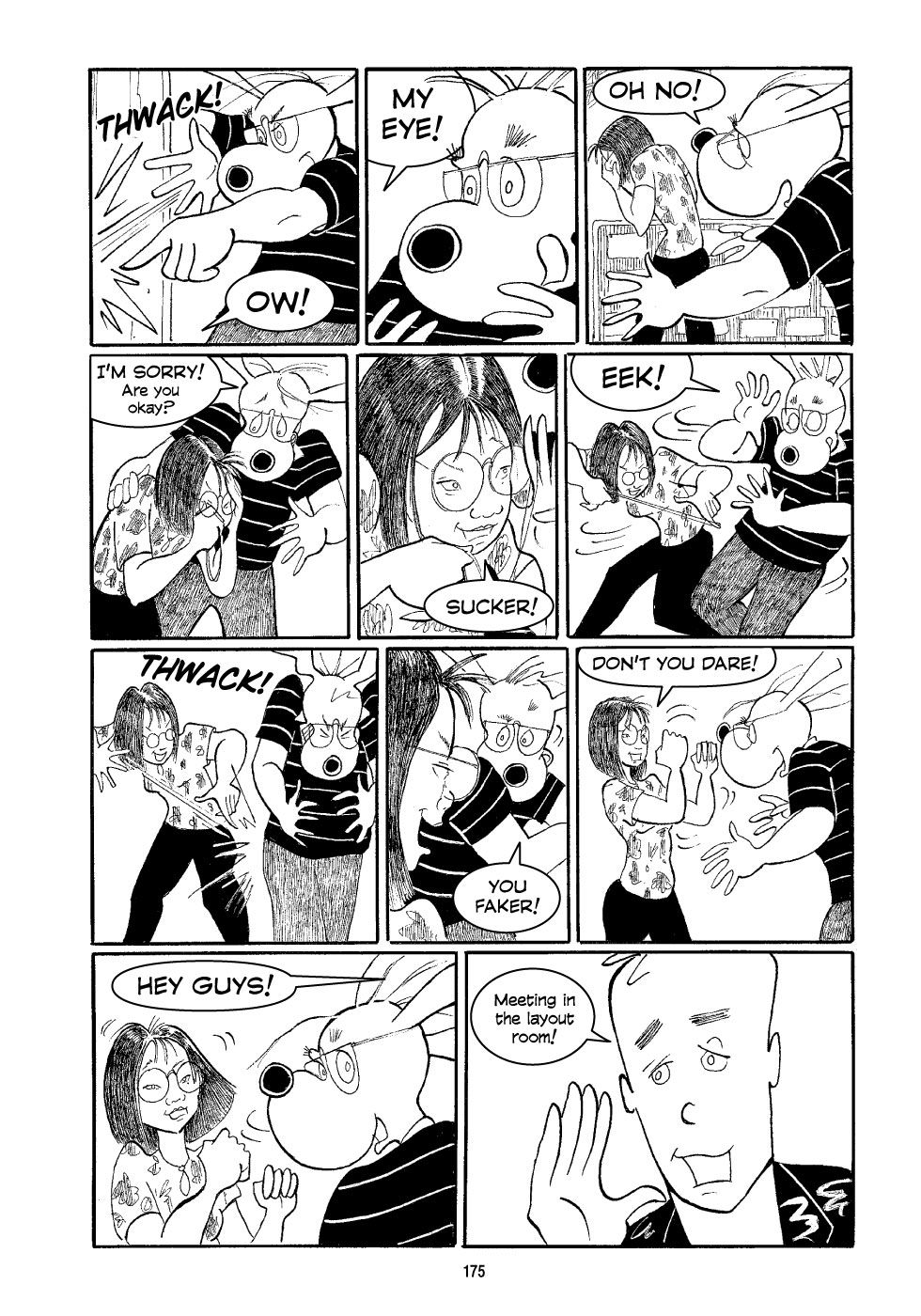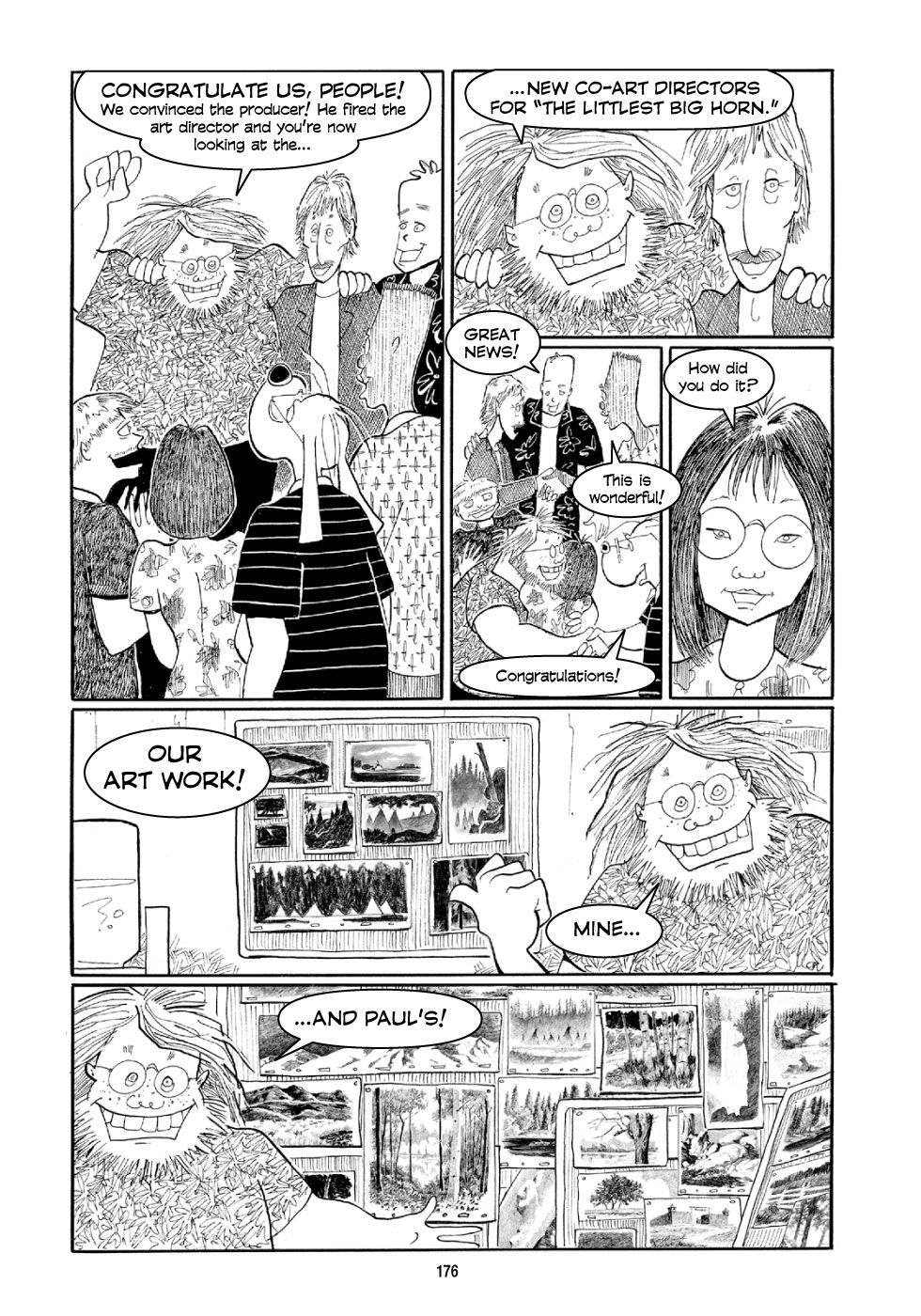I've been a fan of Mark Kalesniko's work for several years now, ever since I came across his wrenching 1997 graphic novel Why Did Pete Duel Kill Himself?, an all-too painful observation of adolescence starring his most regular character the dog-faced animator Alex.
Kalesniko followed up that book with the acclaimed Mail Order Bride, and then a collection of his earlier Alex stories, but he's been quiet since then. As he notes in the interview below, however, he hasn't given up on comics, but working on his latest comic, the soon-to-be-released from Fantagraphics book, Freeway.
As the title hints, Freeway finds Alex stuck in a seemingly endless L.A. traffic jam, where, as his nerves begin to fray, he re-examines his life, particularly his supposed "dream job" as an animator with a legendary studio, and imagines what his life and career might have been like if he had been born several decades earlier.
Kalesniko keeps a number of different narrative threads and timelines going here, segueing back and forth from the past to the present and from Alex's imagination to reality. What's impressive is how he's able to keep all those plot lines together without confusing the reader or losing track of his larger themes. Freeway is an impressive book from an underrated talent and I was happy for the opportunity to talk to Kalesniko about the book and his working methods.
Correct me if I'm wrong, but apart from the 2006 Alex collection this is the first original graphic-novel of yours since 2000's Mail Order Bride. Why the long gap in between projects and what got you back into comics again?
Yes, Freeway is the first original graphic novel since Mail Order Bride. I never left comics, it's just that Freeway took alot longer to complete then my other books. Mail Order Bride and Alex both took about 3 to 4 years to complete, Freeway took 10 years. The reason being — and what I did not take into consideration when I started the book — was it's complexity. Freeway is set in 3 different time periods and the research involved especially in showing L.A of the forties and particularly Bunker Hill which does not exist anymore, took some time. For example, I use Angels Flight in my story, a popular funicular railway here in L.A. To my surprise, Angels Flight is trademarked and I had to get permission to show it in my book. Also I wanted a book that was beautiful to look at that would take the audience on a visual trip. To do that I had to render each drawing quite extensively which is also very time consuming. And because the book is set on a freeway during multiple traffic jams I drew many cars. The beauty of cars are that they are both solid and fluid and for me quite a challenge to draw especially when there are hundreds of them through out the story. But my hope is that when the reader looks at Freeway they will see a visual treat on every page that they can go back and enjoy over and over again and that the art will compliment the story .
How did the concept of the book come to be? Where did you initially get the idea of Alex being stuck in a traffic jam as the bridge for the book?
I came up with the idea of Freeway while stuck in a traffic jam on the freeway. I became aware of how my mind wandered from one thought to another, from the past, to the present, to the future and back again. I thought this would be a great way to tell a story in a non-linear fashion where I could explore the characters life as well as his fears and fantasies. I used for inspiration the movie Slaughterhouse Five and how the main character, unstuck in time, bounced back and forth though out his life. Also the miniseries Singing Detective where the main character is bedridden with a skin disease and suffers from hallucinations and flashbacks. I also thought that the reader would relate to this because many of us have been stuck in traffic jams or other places where we can't move but our mind is free to wander.
Also as a sidenote, I loved the use of music in the Singing Detective and wanted to do the same thing in my book. So every chapter break in Freeway is a song title which acts as the theme of that chapter. I was also going to print the music and lyrics of each song/chapter in the book but I found that the cost to use the music was a little too much and threw that idea out.
You do a lot of jumping back and forth through different timelines in Freeway, and between Alex's imagination and the "now" of the traffic jam. How were you able to keep track of the different threads and not let any one overwhelm the others? Can you talk about some of the visual tricks you used to keep the reader from getting lost?
When I started thinking up the idea of Freeway I settled on four stories that I would tell. They are: the freeway/traffic jam, the present/work and girlfriend, the forties and the seventies. I then plotted out the key points of each story on index cards. Each index card was a different color to represent that particular story. For example, the freeway/traffic jam was written on white cards, the seventies were written on pink cards, etc. Once each story was roughly plotted out, I began to pin the cards on a board in the order I felt the story should go. The colors helped me visually to keep track of which story was popping up next and I let instinct take over to "shuffle" the full story into something that was coherent.
From there I began to write the script, taking similar themes in each of the 4 stories and putting them together for a certain chapter. For example in Chapter 3, If You Were The Only Girl In The World, the theme is the women in Alex's life and I have Alex dating Chloe in one time line and him obsessed over the mystery girl on the freeway in another time line. Once the script was done then I did a page breakdown for each chapter by drawing tiny rough pages and adding the visual elements to the story. I found that each new stage would help with refining the story. After that I drew the actual pages.
I noticed you used some Photoshop-esque effects to let readers know initially when a flashback was occurring. Was this the first time you used computers in creating your comics, and if so, what did the process give you?
The visual trick I used the most was the fade-in, fade-out from one time period to another, which was created by Photoshop. When I first started the book I did not own a computer. So when I did the first fade out, it was created with a xerox of one drawing on a clear cell placed over a faded xerox of another drawing, then I would touch it up with chalk and ink. Once I got the computer and became familiar with Photoshop, the technique went a lot quicker.
Another visual trick was the close up, where I would use a close up of a character's face as the bridge between two time lines. Also in one scene I used a close up of a lunchtruck to cut from the freeway to the studio and in another scene I used close up of pigeons to cut from the studio back to the freeway.
I'm assuming Freeway, and most of the Alex stories in general, are drawn upon your own life experiences. To what extent does fictionalizing your experiences, say, with animation, give you that a straight-up autobiography wouldn't?
Yes, I do draw from my own life experiences for my Alex stories but they are in no way autobiographical. I am writing a fiction story that not only take experiences from my own life but also stories I hear from other people and even events that are not related to the subject I am writing about. For example in reality, a bully never entered my house to beat me up as depicted in Why Did Pete Duel Kill Himself. That incident actually happened to another child in our neighborhood but I incorporated it into the Alex story to fully paint the horror of a bully out to get you. The beauty of fiction is to combine different ideas from many different sources to make a story that is coherent and interesting for the reader. Also in fiction the story can wrap up to a conclusion that is satisfying to both the author and the reader, while reality doesn’t always conclude so neatly. Not to mention my own life is pretty dull.
I don't mean to keep harping on the autobiographical angle -- I completely understand what you're saying -- but you did work as an layout artist, as Alex does. I was just wondering if Freeway afforded you an opportunity to vent about the things that frustrated you about the animation industry.
Of course I had frustrations in my profession, I’d be lying if I said I didn’t, but it is no different then any other profession, all have there certain frustrations and joys. It is the conflict of perception and how it is handled that is interesting. If you perceive a place to be a utopia when it’s just a business, with real people with real issues, it becomes difficult reconciling those conflicting ideas. I think in any business that is perceived as ‘fun,’ be it the arts, toy design, gaming, amusement parks, even careers dealing in foreign travel. People will tell you, “Wow what a great job. It must be fun.” It can be fun but it is still a job, nothing more and nothing less. In the case of Alex, he is facing that conflict, that the dream job is still just a job.
My story is set in the 2D animation world and even thought I tell of some of the frustrations of that business, I am also honored that I was a part of it. With the rise of digital animation it is sad that 2D feature animation is disappearing. 2d is a beautiful artform and the artists who work in it are some of the finest artists I know. I hope there will be a resurgence of 2d animation in the near future.
Reading Freeway, I wondered if one of the themes of the issue wasn't the dangers of nostalgia, especially nostalgia for a time before one was born. Alex seems to really idolize that "golden age of animation," to the point that he, as you note, imagines an alternate version of himself in that world. But you seem to hint rather strongly in the book that that golden age had just as much politics and problems as our modern one and that Alex's rose-colored perspective tends to make him ill-equipped to handle the problems that come his way. Is that an accurate reading?
You are absolutely correct. Like Alex, I too fight a nostalgia of the past be it my own personal past or the greater history. I will sit and think of a time period from my recent past and say to myself, “It was better then,” then I’ll look at my journal of that time period and find out it wasn’t that great. But also the crippling nostalgia is one part of a greater theme that I tackle in Freeway, and that is what we imagine things to be and what those things truly are do not always match up. It’s that conflict of perception that is the theme of not only Freeway but all of my books. In Alex, Alex leaves animation to move back home because it didn’t live up to his ideal. In Pete Duel, young Alex wonders why his favorite actor, who had everything, would kill himself. And in Mail Order Bride, Monty’s exotic fantasy bride is really just a woman. In Freeway, it is the same thing, he imagines this Golden era of animation to be a better time until later on when he finds that it was just like today with all the same office politics and failed ambitions.
I've wanted to ask you for awhile, why does Alex have a dog's head? Is there any special significance to that?
Alex was originally created in the late '60s when I was a kid. The original Alex went on adventure stories along the lines of Carl Barks’ Donald Duck. As I got older, I wanted to create stories with more complex themes and decided to take Alex and make him the hero of these stories. I felt by taking a character I created as a child and putting him into adult situations made for an interesting dynamic. I found that using a dog to represent Alex reflects his alienation and loneliness. For the reader, the dog evokes a sense of distance and perspective in seeing elements of the plot, just as animals were used in fairy tales centuries ago to represent different ideas. Alex doesn’t actually look like a dog to his friends and family, that is the way he sees himself. He feels he is different. I explore this in Freeway, where in the romanticized past of the forties, Alex sees himself as a human.
Without giving anything away to readers, the ending of Freeway seems to close the book (so to speak) on Alex. Are you planning on doing more Alex books in the future or is this the last one? What are you working on next?
There will be more Alex stories. I am currently finishing up a 3 page short story about Alex as we do this interview. I do not have any big Alex books planned for the future. I am hoping to do a series of short stories with Alex that I will be giving away on my blog. As for other graphic novels, I have a number of ideas I am playing with including a science fiction idea but I have not yet decided which one I will pursue next. I will probably write maybe two rough story outlines out first and see which one feels the most interesting to work on and go from there.


